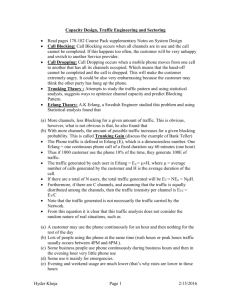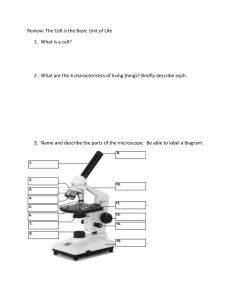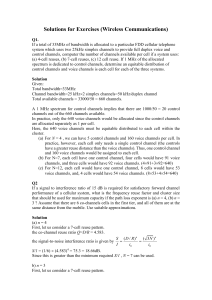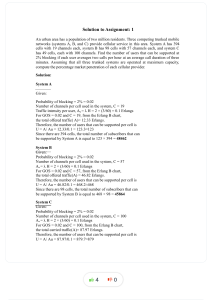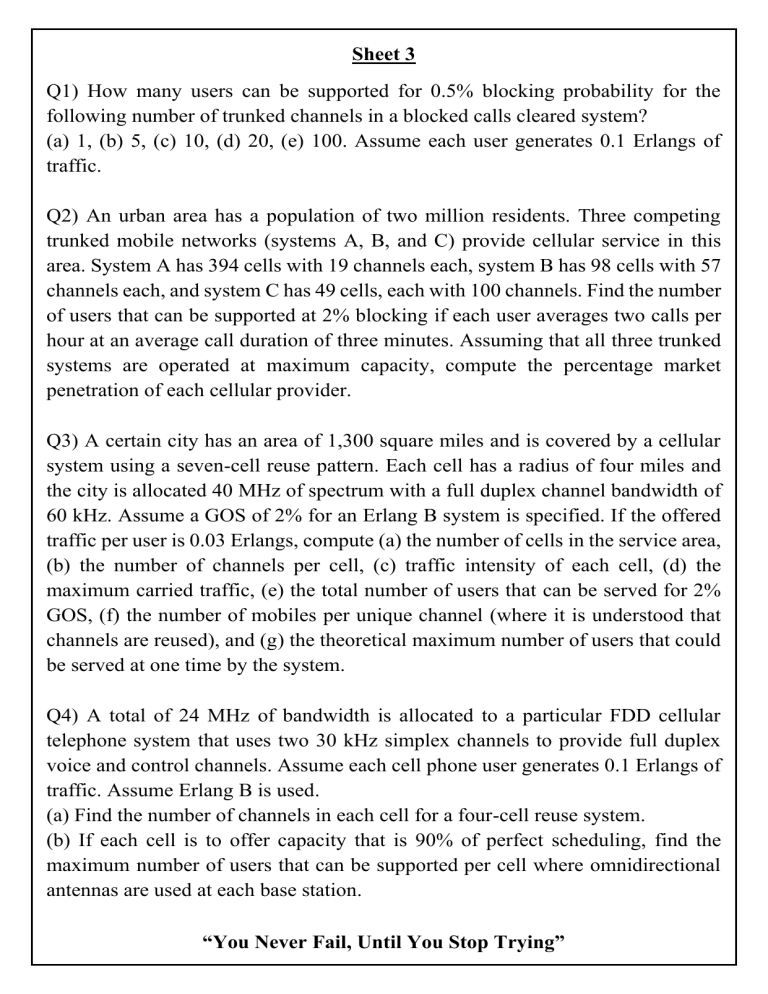
Sheet 3 Q1) How many users can be supported for 0.5% blocking probability for the following number of trunked channels in a blocked calls cleared system? (a) 1, (b) 5, (c) 10, (d) 20, (e) 100. Assume each user generates 0.1 Erlangs of traffic. Q2) An urban area has a population of two million residents. Three competing trunked mobile networks (systems A, B, and C) provide cellular service in this area. System A has 394 cells with 19 channels each, system B has 98 cells with 57 channels each, and system C has 49 cells, each with 100 channels. Find the number of users that can be supported at 2% blocking if each user averages two calls per hour at an average call duration of three minutes. Assuming that all three trunked systems are operated at maximum capacity, compute the percentage market penetration of each cellular provider. Q3) A certain city has an area of 1,300 square miles and is covered by a cellular system using a seven-cell reuse pattern. Each cell has a radius of four miles and the city is allocated 40 MHz of spectrum with a full duplex channel bandwidth of 60 kHz. Assume a GOS of 2% for an Erlang B system is specified. If the offered traffic per user is 0.03 Erlangs, compute (a) the number of cells in the service area, (b) the number of channels per cell, (c) traffic intensity of each cell, (d) the maximum carried traffic, (e) the total number of users that can be served for 2% GOS, (f) the number of mobiles per unique channel (where it is understood that channels are reused), and (g) the theoretical maximum number of users that could be served at one time by the system. Q4) A total of 24 MHz of bandwidth is allocated to a particular FDD cellular telephone system that uses two 30 kHz simplex channels to provide full duplex voice and control channels. Assume each cell phone user generates 0.1 Erlangs of traffic. Assume Erlang B is used. (a) Find the number of channels in each cell for a four-cell reuse system. (b) If each cell is to offer capacity that is 90% of perfect scheduling, find the maximum number of users that can be supported per cell where omnidirectional antennas are used at each base station. “You Never Fail, Until You Stop Trying” (c) What is the blocking probability of the system in (b) when the maximum number of users are available in the user pool? (d) If each new cell now uses 120° sectoring instead of omnidirectional for each base station, what is the new total number of users that can be supported per cell for the same blocking probability as in (c)? (e) If each cell covers five square kilometers, then how many subscribers could be supported in an urban market that is 50 km × 50 km for the case of omnidirectional base station antennas? (f) If each cell covers five square kilometers, then how many subscribers could be supported in an urban market that is 50 km × 50 km for the case of 120° sectored antennas? “You Never Fail, Until You Stop Trying”


